서 론
고추장은 간장, 된장과 함께 한국 고유의 전통발효식품으로 전분질의 단맛과 고추의 매운맛, 콩의 구수한 맛, 소금의 짠맛이 어우러져 독특한 풍미를 나타낸다(1). 또한 매운맛의 자극성으로 식욕을 증진시켜(2) 한국인 뿐 아니라 세계인의 입맛을 사로잡는 향신 조미료의 하나로 자리 잡고 있다. 고추장을 제조하는 방법은 전통식, 개량식으로 나누어지며 전통식 고추장은 각 지역, 각 가정마다 원료, 제조방법을 달리하여 다양한 특성을 나타내는데 지역마다 전분질원(찹쌀, 보리 등)을 달리하여 제조하거나 가정별로는 과실(사과, 감 등)을 첨가하여 제조하는 경우가 있다(3-4). 특히 경북지역은 고추장 제조 시 사과를 첨가하기도 하고 상주, 청도, 정읍 등에서는 감을 이용하여 제조하기도 하였다(5). 또한 고추장의 관능적 품질 및 기능성 향상을 위하여 부 원료를 첨가하여 고추장을 제조하기도 하는데 이에 대한 연구로 사과, 오렌지, 파인애플 등 과즙을 첨가한 고추장(6), 단감(7), 키위(8), 마늘(9), 해양심층수염 및 다시마(10), 고추씨(11), 오미자(12)등을 첨가한 연구 등이 있다. 그러나 대부분의 연구는 단순 첨가에 그쳐 있으며, 발효물을 첨가한 경우는 톳 발효 추출물을 첨가한 고추장의 연구(13) 등으로 시도되고 있으나 현재 초보적인 수준에 머물러 있다.
사과(Malus pumila Miller)는 쌍떡잎식물 장미목 장미과 낙엽교목 식물이며, 다년생 목본식물로, 사과는 전 세계 과일 생산량 중 4위를 차지하며, 한국에서는 과실 생산량의 45% 이상을 차지하는 가장 중요한 과일이다(14). 사과는 유기산과 수용성 펙틴의 함량이 높으며, 식이섬유, 폴리페놀, 비타민 C 등 다양한 기능성 성분을 함유하고 있어 심혈관 질환 및 다이어트, 성인병 질환에 효과가 있는 것으로 알려져 있다(15-16). 사과는 주로 후식용 생과로 이용하거나 샐러드로 먹지만 사과를 활용하여 주스, 사이다, 잼, 식초, 술, 건조 칩, 사과파이 등 다양한 식품의 제조에 이용하고 있다(17). 또한 기능성이 풍부한 사과는 식물성 프로바이오틱 식품의 원료로 유용하게 이용될 수 있어 사과 발효에 적합한 균주선발(18) 및 Lactobacillus rhamnosus(19)와 L. casei(20)를 이용한 사과 발효 음료 개발 등의 연구가 진행되었다.
다양한 사과의 연구가 이루어지고 있으나 사과 생산농가의 애로사항은 생과로 이용되지 못하고 외형상의 흠집만 있을 뿐 영양학적 가치는 비슷한 비품의 발생으로 재배농가의 손실은 높아지고 있다. 이의 안정적인 처리 및 소득증대를 위해서는 원료의 다양화 가공 기술개발이 절실하게 요구되고 있다.
따라서 본 연구에서는 다양한 효능을 지닌 사과를 유산균으로 발효한 후 사과발효액을 만들고 이를 첨가하여 고추장을 제조한 후 품질 및 생리활성 기능적 특성을 조사한 후 고부가가치 고추장의 개발 가능성에 대하여 검토하였다.
재료 및 방법
본 연구에서 사용된 사과는 전북 장수에서 2017년 재배한 사과를 착즙하여 판매되는 100% 사과 착즙액(Jangsudream Co., Ltd., Jangsu, Korea)을 사용하였으며, 쌀, 찹쌀, 고춧가루 등은 전북 순창군에서 재배된 것을 구매하였다. 그 외의 소금(Hanju Co., Ltd., Ulsan, Korea), 물엿(Obok Co., Ltd., Busan, Korea) 발효주정(Ethanol Sales World Co., Ltd., Jeonju, Korea) 등의 부재료들은 시중에서 구입하여 사용하였다.
사과 발효에 적합한 발효 균주는 (재)발효미생물산업진흥원(Sunchang, Korea)에서 기보유중인 유산균 중에서 사과와 적용하여 발효식품 적용가능성을 확인 후 발효균주로 사용하고자 하였다. 사과 착즙액을 멸균하여 식힌 후 Lactobacilli MRS broth(DB Difco Laboratories, Detroit, MI, USA)에서 전 배양시킨 선발된 발효균주 L. sakei SRCM 101057를 1%(w/v) 접종하여 30℃에서 24시간 발효하여 사과발효액으로 이용하였다.
사과 발효액을 이용한 고추장 제조는 Aspergillus 속 곰팡이(Choongmooferementation Co., Ulsan, Korea)를 사용하여 쌀 코지를 제조하고 이에 찹쌀가루, 천일염 등의 부재료의 비율을 결정하고 첨가하고 사과발효액과 혼합하여 1차 숙성물을 제조하였다. 쌀 코지는 멥쌀(전북 순창)을 물에 12시간 이상 침지 한 후 121℃에서 30분간 가열하여 식힌 후 발효균주인 A. oryzae를 접종하였고, 30℃에서 습도 80%이상으로 72시간 발효 후 건조, 분쇄하여 코지를 제조하였다. 대조구로는 사과를 첨가하지 않고 제조한 숙성물과 사과를 발효하지 않고(사과착즙액) 첨가한 숙성물 2구간을 제조하였다. 1차 숙성물은 30℃에서 발효하며 발효기간에 따라 아미노태질소 값이 적정 수준까지 증가함을 확인 한 후 물엿, 주정 등의 비율을 결정하고 혼합하여 사과 발효 고추장을 제조(Table 1)하여 37℃에서 2주간 숙성하여 시료로 사용하였다.
고추장의 이화학적 특성은 다음과 같은 방법으로 측정하였다. 수분함량은 적외선수분측정기(JP/FD-720, Kett engineering, Tokyo, Japan)를 이용하여 측정하였다. pH 및 산도, 아미노산성 질소는 자동적정장치 T50(Mettler-Toledo GmbH, Greifensee, Switzerland)를 이용하여 3번 반복하여 측정하였다(21,22). 색도는 색차계(Model CR-400, Minolta Co., Ltd., Tokyo., Japan)로 Hunter scale에 따라 lightness(L) 값으로 표시하였다. 염도는 시료 10 g을 취해 증류수 90 mL을 가하여 충분히 혼합한 후 디지털 염도계(TM-30D, Takemura Electric works Ltd., Tokyo, Japan)를 이용하여 측정한 값에 희석배수를 곱하여 나타내었다.
유기산과 유리당의 분석은 Shin 등(23)의 방법을 변형하여 분석하였다. 고추장 5 g에 증류수 45 mL를 가하여 1시간동안 균질화 시킨 후 0.45 μm membrane filter에 통과시킨 후 시료로 사용하였다. 전 처리된 시료 20 μL를 RID, DAD detector(210 nm), Aminex column HPX-87P(300×7.8 mm), 이동상 5 mM H2SO4을 사용하여 50℃에서 분당유속 0.6 mL의 조건으로 HPLC(Agilent 1200 series, Agilent Technologies, Santa Clara, CA, USA)로 동시에 분석하였다.
유리아미노산은 고추장 2 g을 취하여 3차 증류수 30 mL 넣고 교반한 후 50 mL로 정용한 후 초음파를 이용하여 20분간 추출한 후 원심 분리하여 상등액 2 mL에 5% TCA 2 mL를 넣고 원심 분리한다. 이 후 상등액을 취하여 0.02 N HCl을 이용하여 2배(v/v) 희석한 후 0.2 μm syringe filter(Adventec, Toyo Roshi Kaisha Ltd., Tokyo, Japan)에 통과시킨 후 amino acid analysis(Hitachi L-8900, Tokyo, Japan), UV/Vis detector(440-570 nm), column(Hitachi 4.6×60 mm speration, Hitachi 4.6×40 mm ammonia filtering)를 사용하여 분석하였다. 시료량은 20 μL, 이동상 Buffer set(PH-SET KANTO, Japan), 분석 온도는 50℃, buffer 유속은 0.40 mL/min, ninhydrin 유속은 0.35 mL/min 으로 분석하였다.
각 시료 100 g에 80% 에탄올을 1 L을 첨가하여 25℃에서 12시간 동안 교반한 후에 원심분리(10,000 ×g, 10분, 4℃) 및 여과 하는 과정을 2회 반복하였다. 여액은 동결 건조하여 시료로 사용하였다. 1,1-Diphenyl-2-picrylhydrazyl(DPPH) 라디칼 소거능은 Blois(24)의 방법을 변형하여 전자공여능(electron donationg abilities, EDA)에 대한 효과로 각 시료의 환원력을 측정하였다. 즉, 시료 50 μL에 0.15 mM DPPH 용액(99%(v/v) MeOH에 용해) 150 μL을 가한 후 30분간 상온에서 방치한 후, 분광광도계를 사용하여 흡광도 517 nm에서 흡광도의 변화를 측정하였다. 각 시료의 라디칼 소거능은 아래 식에 의해 시료 첨가구 및 무첨가구 사이의 흡광도 차이를 백분율(%)로 나타내었다.
Superoxide dismutase(SOD)-like 활성은 SOD determination Kit(Sigma-Aldrich Co., St. Louis, MO, USA)를 사용하여 측정하였으며, 시료별 처리 후 450 nm 에서 흡광도를 측정하였다. 활성 값은 kit에서 제공하는 계산식에 의하여 산출하였다.
고추장을 3배수 증류수로 100℃에서 3시간동안 열수 추출하였다. 각 추출물은 0.2 μm syringe filter(Adventec, Toyo Roshi Kaisha)로 여과하고 저온 감압 농축기를 이용하여 45℃에서 농축한 뒤 -70℃에서 동결건조 후 회수하여 시험에 사용하였다.
실험에 사용한 Raw 264.7(대식세포)은 한국세포주은행(KCLB, Seoul, Korea)으로부터 분양받아 사용하였으며, 세포 배양에 필요한 시약은 Gibco(Rockville, MD, USA)에서 구입하였다. 세포 배양 배지는 10% fetal bovine serum(FBS)과 1% antibiotics-antimycotic을 함유한 Dulbecco's modified Eagle's medium(DMEM) 배지를 이용하여 37℃와 5% CO2 세포 배양기(Thermo, Carlsbad, CA, USA)에서 배양하였다. 시료 처리에 의한 농도 의존적 세포생존율은 WST-1 assay (ITSBio, Seoul, Korea)로 측정되었다. 배양된 세포를 96-well plate에 1×105 cells/well가 되도록 분주하였다. 24시간 배양 후 시료를 농도별로 처리하고 WST-1 시약을 100 μL당 10 μL씩 첨가하여 반응시킨 뒤 microplate reader(Infinite 200, Tecan Trading AG, Mannedorf, Switzerland)를 이용하여 450 nm(Ref. 600 nm)에서 흡광도를 측정하였다. 세포의 생존율은 다음과 같은 공식을 이용하여 산출하였다.
LPS의 처리에 의한 면역 증진 효과를 관찰하기 위하여 Raw 264.7(대식세포)를 96-well plate에 1×105 cells/90 μL/well로 분주하고 각 24시간 배양하였다. 이 후 LPS 10 μg/mL와 농도별 추출물을 처리하여 37℃, 5% CO2에서 각각 24시간, 48시간 동안 배양한 뒤 WST-1 시약을 이용하여 비장세포 증식률을 분석하였다.
NO 측정은 Raw 264.7(대식세포)를 24-well plate 에 3×105 cells/well이 되도록 분주하고 24시간 배양하였다. 이 후 시료를 농도별로 처리하여 1시간동안 반응시킨 뒤 각 well에 LPS를 10 μg/mL 농도로 처리하여 24시간 배양하였다. 배양 후에는 배양 상층액 100 μL를 취하여 동량의 Griess(Sigma-Aldrich Co.)시약을 첨가하고 10분간 방치하였고 570 nm에서 흡광도를 측정하였다. 생성된 nitrite의 농도는 sodium nitrite(Sigma-Aldrich Co.)를 DMEM 배지에 용해한 표준곡선을 이용하여 계산하였으며 생성된 nitrite 양의 차이를 기준으로 각 시료의 NO 생성 저해활성을 확인하였다.
결과 및 고찰
사과 미첨가, 사과 첨가, 사과 발효 고추장의 이화학적 특성을 분석한 결과는 Table 2와 같다. 3가지 고추장의 수분함량은 31.78-34.38%를 나타내어 시판 중인 고추장의 수분함량 30.39-36.86%(25)과 비슷한 함량을 나타내었다. 염도는 6.4-6.5%로 시료 간 차이는 크지 않았다. pH는 4.21-4.56으로 Lee 등(26)의 결과(4.59-4.74)와 유사한 값을 나타내었으며 시료 간 유의차는 없었다, 고추장에 있어 아미노산성 질소 함량은 숙성도 및 품질기준을 제공하는 요인으로 단백질이 유리아미노산으로 어느 정도까지 분해되는 지를 판단하는 기준이다(27,28). 3가지 고추장의 아미노산성 질소함량은 153.1-176.8 mg%를 나타내었으며, 사과발효고추장이 가장 높은 값을 나타내었다. 이는 사과를 발효했을 때 발효에 관여한 미생물의 생육과 생성된 효소에 의해 고추장의 유리아미노산이 증가되었을 것으로 추측된다. 고추장의 색도(lightness)는 23.25-23.76으로 시료 간 차이를 보이지 않았다.
고추장의 단맛은 발효미생물이 전분질을 가수분해하여 생성되는 유리당에서 유래한다(29). 고추장의 유리당은 Table 3에 나타내었는데 maltose, glucose, fructose가 검출되었다. 그 중 glucose 함량이 가장 높게 나타났다. 사과 첨가 고추장과 사과 발효고추장은 사과 미첨가 고추장에 비해 glucose와 fructose함량이 높게 나타났으며 사과의 첨가에 따라 유리당의 함량이 달라진 것으로 사료된다. Jeong 등(30)에 따르면 사과고추장의 주요 유리당은 maltose, glucose, fructose으로 분석되어 본 연구결과와 유사한 경향을 나타내었으나 함량의 차이는 maltose가 가장 높은 함량을 나타내어 상이한 결과를 보였다. 이는 고추장의 숙성기간, 숙성방법 등이 상이하여 차이가 있는 것으로 사료된다. 본 연구의 시료별 고추장의 주요 유기산은 citric acid, succinic acid, lactic acid, acetic acid가 검출되었다. 사과 발효 고추장에서 모든 유기산 함량에서 높은 값을 나타내었는데 이는 사과의 유산균 발효액을 첨가하여 유기산 발효를 촉진시켜 나타난 결과라고 사료되어진다. Park과 Park(31)의 보고에 따르면 유기산의 함량이 본 연구결과에 비해 높은 함량을 나타내나 이는 고추장의 제조방법 및 원료가 상이하여 보여진 결과라고 사료된다.
고추장의 유리아미노산은 미생물에 의해 분해되는 효소에 의해 고추장 원료의 단백질이 펩타이드로 가수분해 되어 생성되며 이를 최종 아미노산으로 생성하여 고추장의 다양한 맛과 향에 영향을 주는 것으로 보고되어 있다(32). 3가지 고추장의 유리아미노산은 24종이 검출되었으며, 사과 미첨가 고추장은 사과 첨가 고추장에 비하여 taurine, cystine, cystathionine, leucine, arginine 등의 함량이 조금 더 높은 것으로 분석되었고, 달콤한 맛을 나타내는 sarcosine이 가장 높은 비중을 나타내었다(Table 4). 사과 발효 고추장은 전반적으로 유리아미노산 항목이 두 가지 고추장에 비해 조금 낮은 수치를 나타내었지만 phosphoserine, threonine, phenylalanine, proline은 사과발효고추장이 가장 높은 값을 보였다(Table 4). 단맛에 영향을 주는 threonine(33), phenylalanine, proline이 높은 것은 사과의 첨가와 사과를 발효해서 첨가하였을 경우 효소활성이 높아짐이 원인으로 다른 고추장에 비해 단맛을 낼 것으로 사료된다. 특히 phosphoserine은 약용버섯(34)이나 발효차(35)에서 많이 함유되어 있는 성분으로 사과 발효 고추장에서만 검출되었다. 이는 발효에 의해 증가된 성분으로 보여져 Choi 등(34)와 hwang 등(35)의 보고와 유사한 결과를 나타내었다. 또한 쓴맛을 나타내는 isoleucine, leucine은 다른 두 가지 고추장에 비해 낮은 함량을 나타내어 사과발효 고추장의 맛을 증진할 것으로 보인다.
고추장의 항산화활성으로 DPPH 라디칼 소거능과 SOD 유사활성을 분석한 결과는 Fig. 1과 같다. 고추장의 DPPH 라디칼 소거능을 측정한 결과 사과발효고추장이 40.16% (100 mg/mL)로 가장 높은 활성을 나타내었으나, 사과 첨가 고추장과 활성 차이는 크지 않았다. 이는 사과 유래의 폴리페놀이 free radical을 쉽게 소거시키거나 억제한 것으로 판단되어진다(36,37). Kim과 Kang(12)에 의하면 오미자 첨가고추장이 미첨가 고추장에 비해 DPPH 라디칼 소거능이 높은 경향을 보고하였으며, Lim 등(38)은 마늘유를 첨가한 고추장이 미첨가고추장에 비해 2배의 항산화활성을 보여 기능성 소재를 첨가한 고추장의 항산화 능력이 향상됨을 알 수 있었다. 고추장의 SOD 유사 활성은 사과발효고추장이 43.12%(100 mg/mL)로 가장 높은 활성을 나타내어 DPPH 라디컬 소거능과 유사한 결과를 보여주었지만 사과 첨가고추장과는 유의적인 차이를 나타내지 않았다. 사과 미첨가 고추장의 활성에 비해 나머지 두 가지 고추장의 SOD 유사 활성이 1.5배가 증가하는 것을 보여 사과의 첨가 유무에 SOD 유사활성이 높아지는 것을 알 수 있었다.
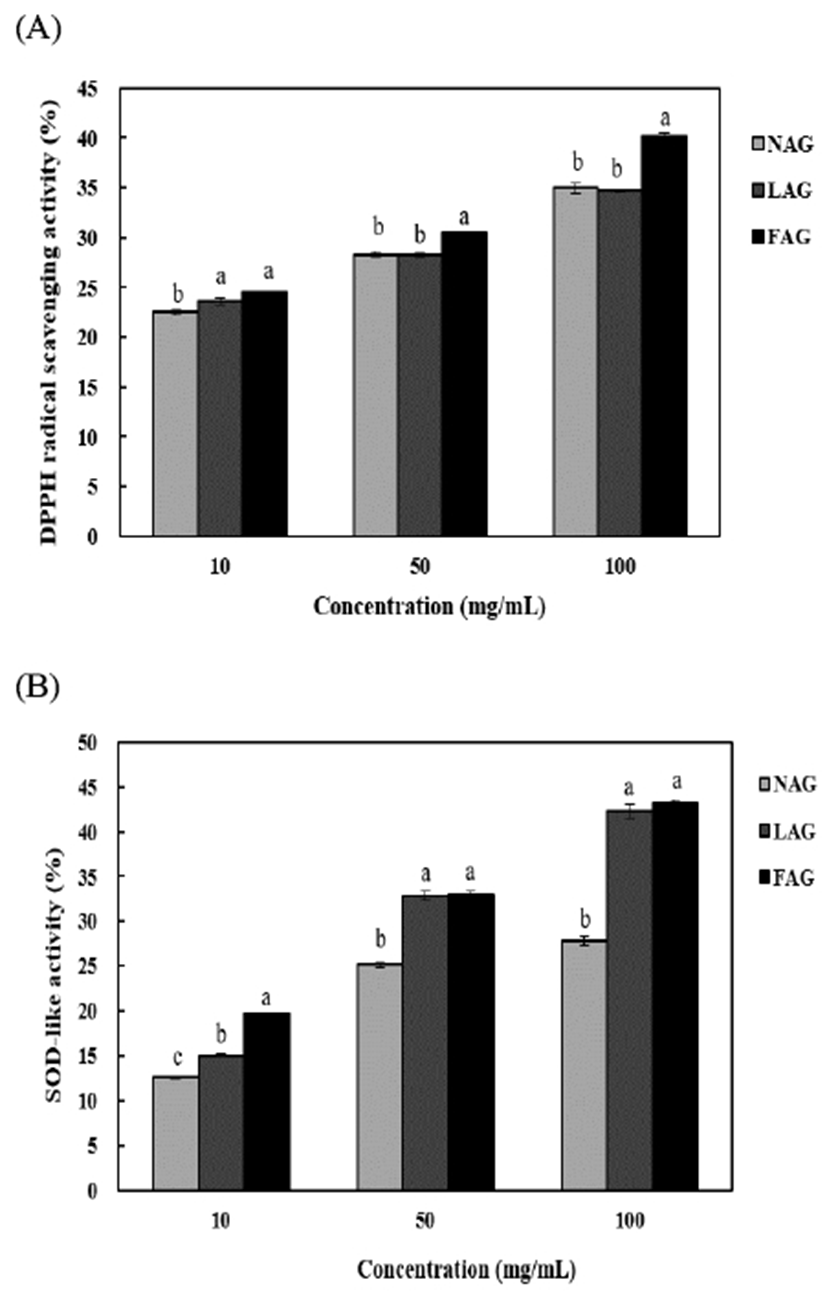
대식세포는 탐식작용을 하는 면역세포로, 인체의 거의 모든 조직에 존재하는 내재면역의 중요한 1차 방어기능을 담당하는데, 세균이나 이물질의 탐색, 제거하는 과정에서 여러 가지 사이토카인과 면역 조절에 필요한 물질들을 분비하는 등 항원에 대한 면역작용을 중추적인 역할을 한다(39,40). 사과 미첨가 고추장, 사과 첨가 고추장 및 사과 발효 고추장 추출물이 대식세포의 생존율에 미치는 영향을 확인한 시험에서 종류별 추출물은 1-100 μg/mL에서는 대조군과 유의한 차이가 나타나지 않았으나 300 μg/mL 이상의 농도에서는 세포 생존율이 급격히 감소하여 시료에 의한 세포 독성이 있는 것으로 확인되었다(Fig. 2). 이에 따라 대식세포를 이용한 시험에서 공시료의 최고 농도는 100 μg/mL로 설정하여 분석하였다.
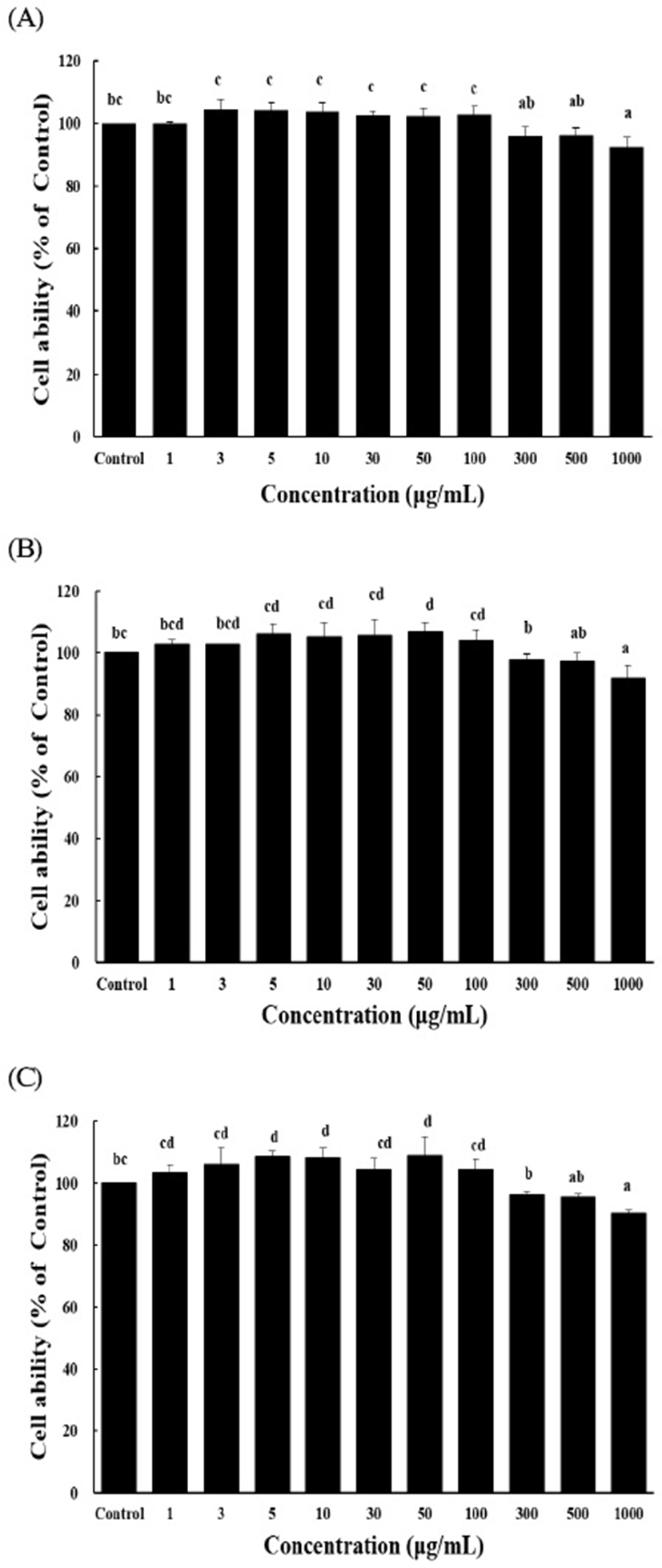
그람 음성균의 외막성분인 LPS는 국소 염증, 항체 생산, 폐혈증과 같은 다양한 반응을 일으킨다(41). 염증에 관여하는 면역세포의 경우 LPS 감염초기에 반응하여 숙주의 방어와 항상성 유지에 중추적인 역할을 한다(42). 사과 미첨가 고추장 추출물을 처리한 시험군은 50 μg/mL에서는 127.0±2.7%, 100 μg/mL에서는 129.5±2.3%로 고농도에서 유의하게 높은 수준을 보였고 사과첨가 고추장 추출물을 처리한 시험군은 50 μg/mL에서는 131.8±3.6%, 100 μg/mL에서는 138.5±5.7%로 유의하게 높은 수준을 보였고 사과발효 고추장 추출물을 처리한 시험군은 24시간 경과 시 10 μg/mL에서는 127.4±4.8%, 30 μg/mL에서는 131.1±4.7%, 50 μg/mL에서는 139.9±468%, 100 μg/mL에서는 145.3±5.3%로 유의하게 높은 수준을 보였다(Fig. 3). 본 연구에서 추출물이 LPS에 의한 대식세포의 증식에 미치는 영향을 분석한 결과 사과첨가 고추장, 사과 발효 고추장 추출물은 사과 미첨가 고추장 추출물과 비교하여 더 높은 활성을 보이는 것으로 나타났다. 이러한 결과 사과를 첨가하거나 발효하여 첨가한 고추장은 대식세포의 세포 생존율을 증가시켜줌으로써 면역 활성 증가에 크게 영향을 주는 것으로 생각된다.
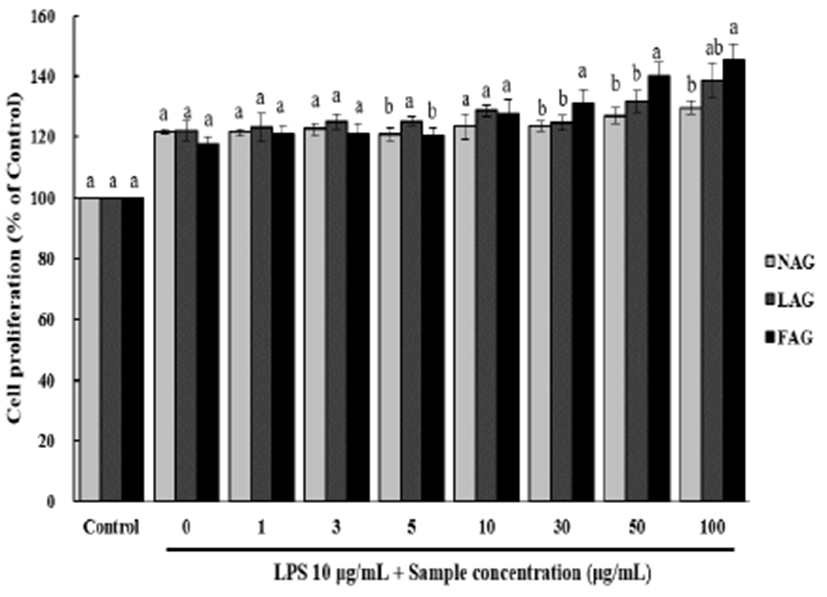
Nitric oxide(NO)는 생리적·병리적 상황 모두에서 중요한 역할을 하는 조절 분자로, 과도하게 생성되는 경우 세포의 염증 및 자멸을 유발하며, 염증인자로서 여러 가지 만성 염증성 질환을 유발하는 원인이 된다(43,44). LPS (lipopolysaccharides from Escherichia coli)는 산화적 스트레스를 유발하여 면역세포 등을 자극함으로서 NI와 PGE2의 생성을 증가시킨다고 보고되어 있다(45). 대식세포에 LPS를 처리하였을 때 NO의 생성량을 확인한 실험에서 LPS만을 처리한 시험군은 24시간 경과 시 5.05±0.51 μM로 무처리군인 대조군의 0.24±0.12 μM 보다 유의하게 높은 것으로 확인되었다(Fig. 4). 사과첨가 고추장 추출물은 30 μg/mL에서 3.97±0.39 μM, 50 μg/mL에서 2.99±0.28 μM, 100 μg/mL에서 2.13±0.31 μM로 미첨가 고추장 추출물에 비해 유의적으로 차이를 보였고, 사과발효 고추장 추출물은 30 μg/mL에서 2.44±0.36 μM, 50 μg/mL에서 2.11±0.37 μM, 100 μg/mL에서 0.88±0.25 μM로 사과 미첨가 고추장 및 사과 첨가 고추장 추출물에 비해 유의하게 낮은 것으로 확인되었다(Fig. 4). 따라서 사과 발효 고추장은 LPS에 의한 NO의 생성량을 감소시켜 산화적 스트레스에 의한 세포 손상을 억제하는데 더 효과적일 것으로 사료된다.
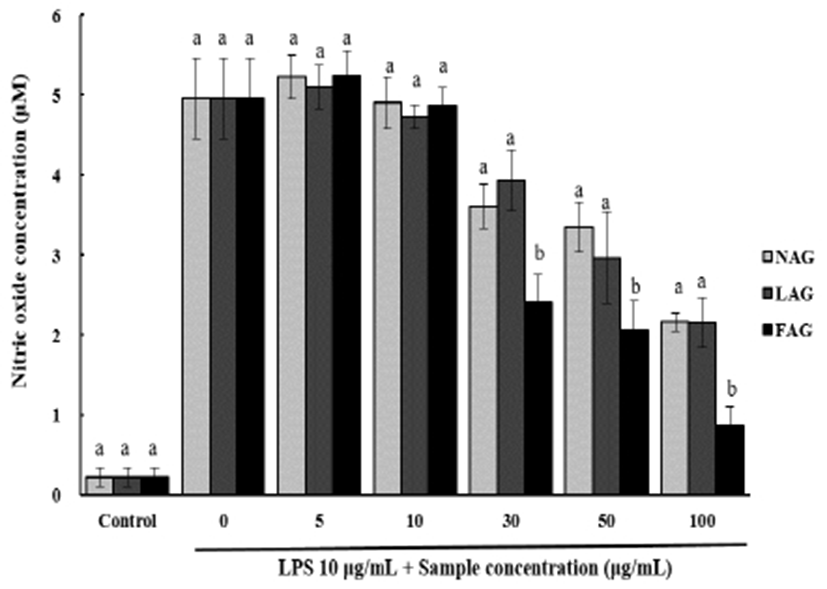
면역세포의 증식반응이 일어나면 여러 종류의 면역반응을 매개하는 사이토카인을 분비하게 된다(46). 대식세포는 면역계에서 중추적인 역할을 하는 B 및 T 림포사이트의 성숙과 항원에 의해 작용을 받은 후 분열과 분화가 이루어지는 주요 임파구이다. 면역세포에서 분비되는 TNF-α는 T 세포에서 분비되는 전구 염증성(pro-inflammatory) 사이토카인으로 알려져 있다(47,48).
면역세포에 고농도의 LPS 자극을 가하는 경우 TNF-α, NO와 같은 염증성 매개물질 분비가 촉진되어 숙주에 치명적인 결과를 초래할 수 있다(49,50). LPS를 처리한 대식세포의 TNF-α 생성량은 24시간 경과 시 153.73±2.36 pg/mL 경향을 보였다. LPS와 사과발효 고추장 추출물을 처리한 시험군의 TNF-α 함량은 50 μg/mL에서 124.93±2.02 pg/mL, 100 μg/mL에서 87.04±2.71 pg/mL로 사과 미첨가 고추장(100 μg/mL: 97.37±3.33 pg/mL) 및 사과 첨가 고추장 추출물(100 μg/mL: 94.60±4.02 pg/mL)에 비해 고농도에서 TNF-α 생성을 억제하는 것으로 확인되었다(Fig. 5). 따라서 사과 발효 고추장은 LPS에 의한 TNF-α 생성량을 감소시켜 염증성 사이토카인에 의한 세포손상을 억제하는데 더 효과적일 것으로 생각되어 항염증 활성에 기여할 것으로 사료된다.
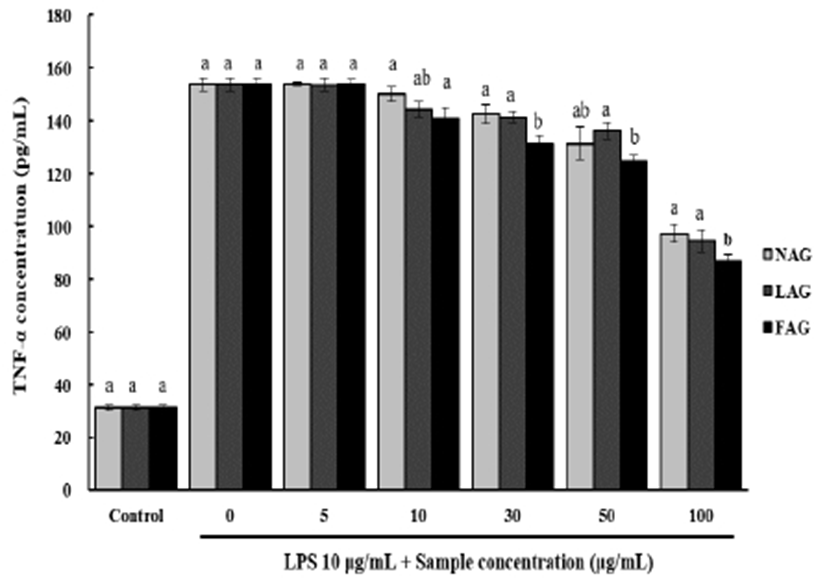
요 약
사과를 Lactobacillus sakei SRCM101057로 접종하고 발효하여 사과 발효액을 제조하고, 이를 사용하여 고추장을 제조하고 이화학적 및 기능성 특성을 분석하였다. 대조구로는 사과 발효액 대신 사과 착즙액을 첨가한 고추장과 사과 미첨가 고추장을 이용하였다. 3종의 고추장 시료는 수분함량 31.78-34.38%, 염도 6.4-6.5%, pH 4.21-4.56, 아미노산성 질소 153.1-176.8 mg%, 색도(L 값) 23.25-23.76으로 나타났다. 사과 발효 고추장의 유리당 분석결과 glucose, fructose가 높은 함량을 보였으며, 유리아미노산은 phosphoserine, threonine, phenylalanine, proline이 유의적으로 높은 함량을 나타내었다. 3종 고추장의 항산화 효과를 분석한 결과 DPPH 라디칼 소거능과 SOD 유사 활성은 사과 발효 고추장이 각각 40.16%(100 mg/mL), 43.12%(100 mg/mL)을 나타내어 유의적으로 가장 높은 활성을 보였다. 고추장이 LPS에 의한 대식세포의 증식에 미치는 영향을 분석한 결과 사과 첨가 고추장, 사과 발효 고추장은 사과 미첨가 고추장과 비교하여 더 높은 활성을 보이는 것으로 나타났다. NO 생성량 및 TNF-α 생성량은 사과 발효 고추장 처리 시 각각 0.88±0.25 μM(100 μg/mL), 87.04±2.71 pg/mL (100 μg/mL)을 나타내어 사과 첨가고추장과 미첨가 고추장 처리에 비해 유의적으로 낮은 생성량을 보였다. 이 결과 사과 발효고추장 처리는 LPS에 의한 NO 및 TNF-α의 생성량을 감소시켜 염증성 사이토카인에 의한 세포손상을 억제하는데 더 효과적일 것으로 사료되었다. 따라서 사과 발효액을 첨가하여 제조한 고추장은 사과 첨가 고추장과 사과 미첨가 고추장에 비해 항산화 활성과 항염증 활성을 나타내어 사과 발효액의 첨가에 의해 고추장의 기능성이 향상되었음이 확인되었다.










